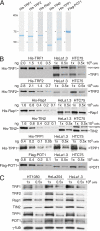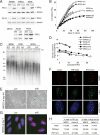In vivo stoichiometry of shelterin components
- PMID: 19864690
- PMCID: PMC2801271
- DOI: 10.1074/jbc.M109.038026
In vivo stoichiometry of shelterin components
Abstract
Human telomeres bind shelterin, the six-subunit protein complex that protects chromosome ends from the DNA damage response and regulates telomere length maintenance by telomerase. We used quantitative immunoblotting to determine the abundance and stoichiometry of the shelterin proteins in the chromatin-bound protein fraction of human cells. The abundance of shelterin components was similar in primary and transformed cells and was not correlated with telomere length. The duplex telomeric DNA binding factors in shelterin, TRF1 and TRF2, were sufficiently abundant to cover all telomeric DNA in cells with short telomeres. The TPP1.POT1 heterodimer was present 50-100 copies/telomere, which is in excess of its single-stranded telomeric DNA binding sites, indicating that some of the TPP1.POT1 in shelterin is not associated with the single-stranded telomeric DNA. TRF2 and Rap1 were present at 1:1 stoichiometry as were TPP1 and POT1. The abundance of TIN2 was sufficient to allow each TRF1 and TRF2 to bind to TIN2. Remarkably, TPP1 and POT1 were approximately 10-fold less abundant than their TIN2 partner in shelterin, raising the question of what limits the accumulation of TPP1 x POT1 at telomeres. Finally, we report that a 10-fold reduction in TRF2 affects the regulation of telomere length but not the protection of telomeres in tumor cell lines.
Figures






References
-
- Greider C. W., Blackburn E. H. (1985) Cell 43, 405–413 - PubMed
-
- Palm W., de Lange T. (2008) Annu. Rev. Genet. 42, 301–334 - PubMed
-
- Chong L., van Steensel B., Broccoli D., Erdjument-Bromage H., Hanish J., Tempst P., de Lange T. (1995) Science 270, 1663–1667 - PubMed
-
- Bilaud T., Brun C., Ancelin K., Koering C. E., Laroche T., Gilson E. (1997) Nat. Genet. 17, 236–239 - PubMed
-
- Broccoli D., Smogorzewska A., Chong L., de Lange T. (1997) Nat. Genet. 17, 231–235 - PubMed
Publication types
MeSH terms
Substances
Grants and funding
LinkOut - more resources
Full Text Sources
Other Literature Sources
Molecular Biology Databases
Research Materials
Miscellaneous

